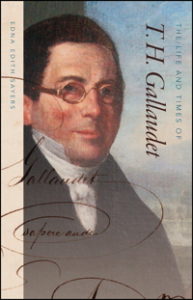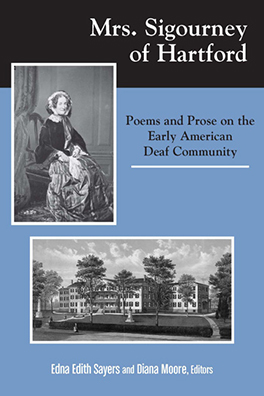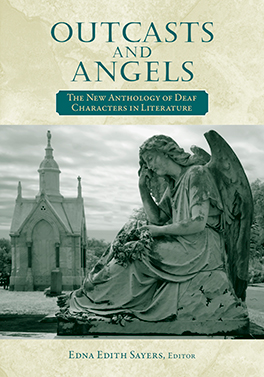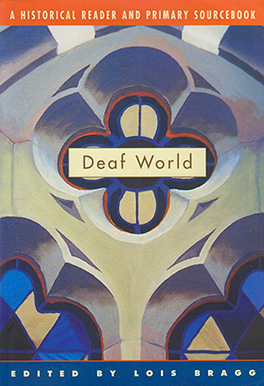N.B.: Some of these publications are also listed on the Literary and Disability Studies page.
Books
 Edna Edith Sayers. The Life and Times of T. H. Gallaudet. Lebanon, N.H.: University Press of New England, 2018.
Edna Edith Sayers. The Life and Times of T. H. Gallaudet. Lebanon, N.H.: University Press of New England, 2018.
T. H. Gallaudet is celebrated today as the founder of deaf education in America. This definitive biography traces Gallaudet’s work in the fields of deaf education, free common schools, literacy, teacher education and certification, and children’s books, while also examining his role in reactionary causes intended to uphold a white, Protestant nation thought to have existed in New England’s golden past.
Gallaudet’s youthful social and political entanglements included involvment with Connecticut’s conservative, state-established congregational Church, the Federalist Party, and the Counter-Enlightenment ideals of Yale (where he was a student). He later embraced anti-immigrant, anti-abolition, and anti-Catholic efforts, and supported the expatriation of free African Americans to settlements on Africa’s west coast. As much a history of the paternalistic, bigoted, and class-conscious roots of a reform movement as a story of one man’s life, this landmark work will surprise and enlighten both the hearing and Deaf worlds.
 Edna Edith Sayers and Diana Moore. Mrs. Sigourney of Hartford: Poems and Prose on the Early American Deaf Community. Washington, D.C.: Gallaudet University Press, 2013.
Edna Edith Sayers and Diana Moore. Mrs. Sigourney of Hartford: Poems and Prose on the Early American Deaf Community. Washington, D.C.: Gallaudet University Press, 2013.
Lydia Huntley was born in 1791 in Norwich, Connecticut, the only child of a poor Revolutionary war veteran. But her father’s employer, a wealthy widow, gave young Lydia the run of her library and later sent her for visits to Hartford, Connecticut. After teaching at her own school for several years in Norwich, Lydia returned to Hartford to head a class of 15 girls from the best families. Among her students was Alice Cogswell, a deaf girl soon to be famous as a student of Thomas Hopkins Gallaudet and Laurent Clerc.
Lydia Huntley’s inspiration came from a deep commitment to the education of girls and also for African American, Indian, and deaf children. She left teaching to marry Charles Sigourney, then turned to writing to support her family, publishing 56 books, 2,000 magazine articles, and popular poetry. Lydia Sigourney never abandoned her passion for deaf education, remaining a supporter of Gallaudet’s school for the deaf until her death. Yet, her contributions to deaf education and her writing have been forgotten until now.
Lydia Sigourney’s work on the nascent Deaf community is presented in this new volume. Her writing intertwines her mastery of the sentimentalism form popular in her day with her sharp insights on the best ways to educate deaf children. In the process, Mrs. Sigourney of Hartford reestablishes her rightful place in history.
 Edna Edith Sayers, ed. Outcasts and Angels: The New Anthology of Deaf Characters in Literature. Washington, D.C.: Gallaudet University Press, 2012.
Edna Edith Sayers, ed. Outcasts and Angels: The New Anthology of Deaf Characters in Literature. Washington, D.C.: Gallaudet University Press, 2012.
In 1976, Trent Batson and Eugene Bergman released their classic Angels and Outcasts: An Anthology of Deaf Characters in Literature. In it, they featured works from the 19th and 20th centuries by well-known authors such as Charles Dickens and Eudora Welty. They also presented less-well-known deaf authors, and they prefaced each excerpt with remarks on context, societal perceptions, and the dignity due to deaf people. Since then, much has transpired, turning around the literary criticism regarding portrayals of deaf people in print. Edna Edith Sayers reflects these changes in her new collection Outcasts and Angels: The New Anthology of Deaf Characters in Literature.
Sayers mines the same literary vein as the first volume with rich new results. Her anthology also introduces rare works by early masters such as Daniel Defoe. She includes three new deaf authors, Charlotte Elizabeth, Howard T. Hofsteater, and Douglas Bullard, who offer compelling evidence of the attitudes toward deaf people current in their eras. In search of commonalities and comparisons, Sayers reveals that the defining elements of deaf literary characters are fluid and subtly different beyond the predominant dueling stereotypes of preternaturally spiritual beings and thuggish troglodytes.
 Lois Bragg, ed. Deaf World: A Historical Reader and Primary Sourcebook (New York: NYUP, 2001).
Lois Bragg, ed. Deaf World: A Historical Reader and Primary Sourcebook (New York: NYUP, 2001).
To many who hear, the deaf world is as foreign as a country never visited. Deaf World thus concerns itself less with the perspectives of the hearing and more with what Deaf people themselves think and do. Editor Lois Bragg asserts that English is for many signing people a second, infrequently used language and that Deaf culture is the socially transmitted pattern of behavior, values, beliefs, and expression of those who use American Sign Language. She has assembled an astonishing array of historical sources, political writings, and personal memoirs, from classic 19th-century manifestos to contemporary policy papers, on everything from eugenics to speech and lipreading, the right to work and marry, and the never-ending controversy over separation vs. social integration. At the heart of many of the selections lies the belief that Deaf Americans have long constituted an internal colony of sorts in the United States.
While not attempting to speak for Deaf people en masse, this ambitious platform anthology places the Deaf on center stage, offering them an opportunity to represent the world–theirs as well as the hearing world–from a Deaf perspective. For Deaf readers, the book will be welcomed as a gift, both a companion to be savored and, as often, an opponent to be engaged and debated. And for the hearing, it serves as an unprecedented guide to a world and a culture so often overlooked.
Articles
Edna Edith Sayers. “From Freak Show to Jim Crow: A Siamese Twin and His Deaf Daughter in the Antebellum and Postbellum South.” Sign Language Studies 22.4 (2022): 553-89.
Edna Edith Sayers. “Unlock(e)ing T. H. Gallaudet’s Philosophy of Language.” Sign Language Studies 21.2 (2021): 208-244. Although Gallaudet founded sign language education for the deaf in the U.S. during the same years European philosophers were founding modern linguistics, he was unable, due to his religious beliefs, to benefit from their thought. His acolytes were therefore unable to defend sign language education against oralist arguments.
Edna Edith Sayers. “White Nation, Black Deportation, Deaf Education: The Agenda of the Founders of Sign Language Education in the United States.” American Annals of the Deaf 165.2 (2020): 136-156.
Edna Edith Sayers. “The Story of a Lonely Deaf Puritan, recovered from Apocryphal Deaf History.” Sign Language Studies 19.4 (2019): 606-27. In 1900, A.G.Bell invented a story about a deaf child, Isaac Kilburn (1660-1713) of Rowley, Mass., having been taught to speak. This essay debunks Bell and tells the real story.
Miriam Nathan Lerner and Edna Edith Sayers. “Deaf Characters in Film.” SAGE Deaf Studies Encyclopedia, eds. Genie Gertz and Patrick Boudreault. 2016.
Edna Edith Sayers. “What’s Up with Helen Keller?” Montage: Deaf Studies Today, 2008, ed. Bryan K. Eldredge, et al. (Orem, Utah: Utah Valley State University, 2015): 461-73. A study of reactions to HK in contemporary Deaf newspapers.
Edna Edith Sayers. “Life After Deaf: Thomas Hopkins Gallaudet after his Retirement from Deaf Education.” Proceedings of the 7th Deaf History International Conference, 2009. (Stockholm, 2011): 216-27. A study of Gallaudet’s career as chaplain at the Hartford Retreat for the Insane and his volunteer work for the American Colonization Society.
Edna Edith Sayers. “Experience, Authority, and the Mediation of Deafness: Chaucer’s Wife of Bath.” A World of Difference: Essays on Disability in the Middle Ages, ed. Joshua R. Eyler (Ashgate, 2010): chapter 6.
Edna Edith Sayers. “A Popular Myth in Deaf History: The Story of Philip Nelson, an Oral Teacher Accused of Witchcraft in Colonial Massachusetts, and the Deaf Boy Who Saved Him by Standing Mute.” Deaf History Review 7 (Edinburgh, 2009): 100-11.
Breda Carty, Susannah Macready, and Edna Edith Sayers. “‘A Grave and Gracious Woman’: Deaf People in Colonial New England.” Sign Language Studies 9.3 (2009): 287-323; Proceedings of the 7th Deaf History International Conference, 2009 (Stockholm, 2011): 188-213.
Edna Edith Sayers, and Diana Gates. “Lydia Huntley Sigourney and the Beginnings in American Deaf Education in Hartford: It Takes a Village.” Sign Language Studies 8.4 (2008): 369-411.
Rachel Channon and Edna Edith Sayers. “Toward a Description of Deaf Students’ Written English: Avoidance, Overuse, and Mastery of Function Words.” American Annals of the Deaf 152.2 (2007): 91-103. A study of how Deaf people write English, noting the lexical and grammatical patterns typical of Deaf writers.
Edna Edith Sayers. “B. H. and Arnold H. Payne: Early Champions of Sign Language in the United Kingdom.” Deaf History Review 5 (2007): 22-30.
Lois Bragg. “Telling Silence: Alingualism in Old Icelandic Myth, Legend, and Saga.” Journal of Indo-European Studies 32 (2004): 267-98.
Lois Bragg. “The Hard of Hearing and the Hardly Heard in Henry Green’s Novels of the 1940s.” Journal of Modern Literature 26.2 (2003): 100-112.
Lois Bragg. “Visual-Kinetic Communication in Europe before 1600: A Survey of Sign Lexicons and Finger Alphabets prior to the Rise of Deaf Education” Journal of Deaf Studies and Deaf Education 2 (1997): 1-25. Survey of finger alphabets and sign lexicons in the Middle Ages and early Renaissance.
Lois Bragg. “The Chaucer Monogram and the ‘Harleian Portrait’ Tradition.” Word & Image 12 (1996): 127-42. Use of finger alphabets in 15th-c. portraits.
John Miles Foley, ed. “Deafness and Orality.” Oral Tradition 8 (1993): 413-37. Edited version of an electronic conversation among eight scholars on whether ASL literature is an “oral traditional” literature. My argument that it is was cited in a recent doctoral dissertation as the first to appear in print.
Selected Unpublished Papers
Lois Bragg. “Deaf Identity, ASL, and Rallying against Audism.” CCCC 2007
Lois Bragg. “Louisa Bunker Haynes and Segregation at the North Carolina School for the Deaf.” Fifth International Deaf History conference, Paris, 2 July 2003.
Lois Bragg. “Deaf World, Deaf History.” Lecture at DC Public Library, 21 August 2002, and Arlington Public Library 31 March 03.
Lois Bragg. “Deaf Studies: A Model for Disability Studies?” Keynote address, Society for Disability Studies (SDS), Washington, DC, 1999.
Lois Bragg. “Deft Mutes and Daft Brutes: Old Icelandic Tales of Dysglossia,” MLA 1998.
Lois Bragg. “Muteness and the Supernatural in Early Iceland.” Invited lecture at University of Iceland, 24 March 1998.
Lois Bragg. “Medieval Signing: Fact, Fiction, and Fantasy.” Invited lecture for the American Sign Language Program, University of Rochester (New York), 5 December 1997.
Miscellaneous Short Publications: Reviews & Advocacy
Edna Edith Sayers, Rvw. of Joseph Fulka, Deafness, Gesture and Sign Language in the 18th Century French Philosophy. Vol. 8 of Gesture Studies, Ed. Adam Kendon (Amsterdam/Philadelphia:John Benjamins Publishing Company:, 2020). In Sign Language Studies, 21.4 (Summer 2021): 496-99.
Edna Edith Sayers, Rvw. of Robin Wallace, Hearing Beethoven: A Story of Musical Loss and Discovery (U Chicago P, 2018). In Deaf History International Newsletter 63 (June 2020): unpaginated.
Edna Edith Sayers, Rvw. of William B. Swett: Adventures of a Deaf-Mute and Other Short Pieces (Gallaudet UP, 2017). In Deaf History International Newsletter 58 (August 2017): 5-7.
Edna Edith Sayers. Rvw. of Signs and Wonders: Religious Rhetoric and the Preservation of Sign Language, Tracy Ann Morse (Gallaudet UP, 2014). In Deaf History International Newsletter 54 (January 2015).
Edna Edith Sayers. Rvw. of People of the Eye: : Deaf Ethnicity and Ancestry, Harlan Lane, Richard C. Pillard & Ulf Hedberg (Oxford UP, 2011). In Deaf History International Newsletter 46 (Fall 2011): 14-15.
Diana Gates and Edna Edith Sayers. “Lincoln Bicentennial Celebration at Gallaudet University.” In Gallaudet Today Winter 2010: 27-29.
Edna Edith Sayers. Rvw. of “Vignettes of the Deaf Character” and Other Plays, Willy Conley (Washington: Gallaudet UP, 2009). In Clerc Scar 15.4 (13 October 2009).
Edna Edith Sayers. Rvw. of Writing Deafness: The Hearing Line in Nineteenth-Century American Literature, Christopher Krentz (Chapel Hill: North Carolina UP, 2007). In Deaf History International Newsletter 39 (Summer 2009): 10.
Edna Edith Sayers. Rvw. of The Avenue: A History of the Claremont Institution, Rachel Pollard (Dun Laoghaire, Ireland: Denzille Press, 2006). In Deaf History International Newsletter Summer 2007: 10.
Lois Bragg. Rvw. of A Deaf Artist in Early America: The Worlds of John Brewster, Harlan Lane (Boston: Beacon, 2004) and of “A Deaf Artist in Early America: The Worlds of John Brewster,” Fenimore Art Museum 1 April – 31 December 2005. In Deaf History Newsletter 24 (2005): 3-5.
Lois Bragg. Rvw. of George Dalgarno on Universal Language, David Cram and Jaap Matt (Oxford UP, 2001). In Deaf History International Newsletter Spring 2003: 17-20.
Lois Bragg. Rvw. of Helen Keller, Public Speaker: Sightless but Seen, Deaf but Heard (Great American Orator Series, No. 23), Lois J. Einhorn (Westport, Connecticut: Greenwood, 1998). In Disability Studies Quarterly 20.5 (2001 for 2000): 358-59.
Lois Bragg. Rvw. of An Intellectual Look at American Sign Language, Tom Bertling (Wilsonville, Oregon: Kodiak Media Group, 2001). In Disability Studies Quarterly 20.4 (2001 for 2000): 450-51.
Lois Bragg. Rvw. of “Writing on Hands: Memory and Knowledge in Early Modern Europe,” Claire Richter Sherman (Washington: Folger Library, 2001). In Deaf History International Newsletter Fall 2000: 10-11.
Lois Bragg. Rvw. of A Prosodic Model of Sign Language Phonology, Diane Brentari (Cambridge, Mass.: MIT P, 1999). In Disability Studies Quarterly 20.1 (2000): 61.
Lois Bragg. Rvw. of Silent Poetry: Deafness, Sign, and Visual Culture in Modern France, Nicholas Mirzoeff (Princeton: UP, 1995). In Gallaudet Today Fall 1997: 29.
Lois Bragg. Report to MLA on access for deaf members, 14 February 1996: 29 pp.
Lois Bragg. Rvw. of When the Phone Rings, My Bed Shakes, Philip Zazove (Washington: Gallaudet UP, 1993) and Listening, Hanna Merker (New York: Harper, 1991). In Gallaudet Today Spring 1994: 32.